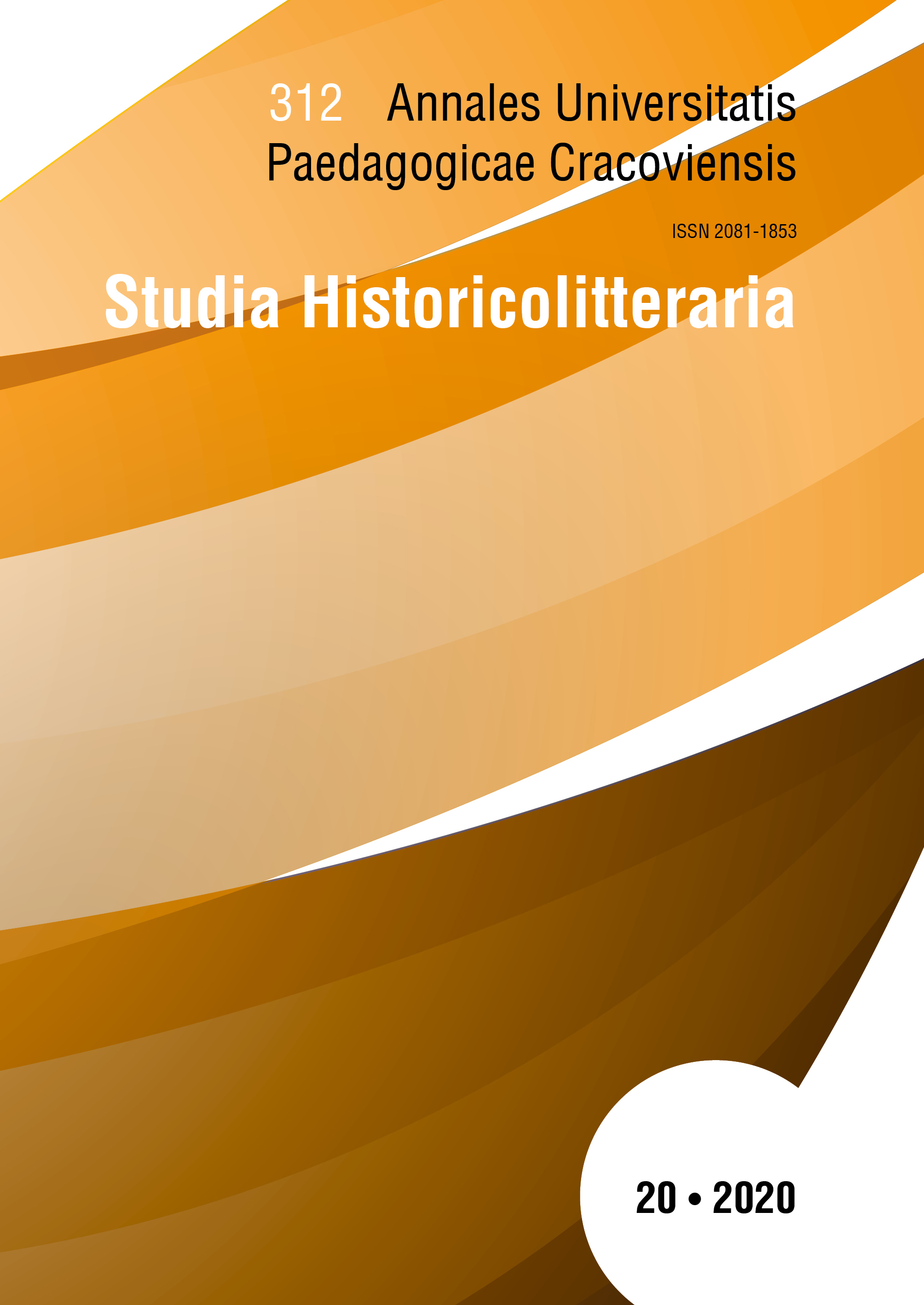Od „śmierdzącego dudka” po banialuki. Obraz ptaków w literaturze renesansu i baroku – rekonesans
Main Article Content
Аннотация
Birds function in Polish literature of Renaissance and Baroque in three paradigms. Mostly they appear as creatures gifted with a symbolic (allegoric) meaning, seen through the prism of the tradition reaching to Aristotle’s Zoology, Physiologist, and later symbological compendia. The second category is describing birds as food or pests (especially in hunting and agricultural literature). Apart from this ‘practical’ paradigm, there is also a third one: birds as a source of an aesthetic thrill, fascination with them includes both lyricism and a ludic element. The first two categories fit into a more general utilitarian paradigm. Handbooks, treaties, sermons, fairy tales, paroemias and animal epigrams showcase birds almost exclusively
as tools of moral, religious and conventional reflection, or as objects to be obtained and consumed. Interestingly, the symbological activity of the creators does not cease in the Renaissance and Baroque periods, the representatives of avifauna are burdened with new meanings, while the fantastic creatures slowly disappear from the creators’ fields of view. In the third group of works distinguished here, one can notice the phenomenon of the emancipation of birds as objects of interest just as they are, although their voice is heard mostly in the digressions scattered throughout the big epic works. The autonomy of birds in the literature of Renaissance and Baroque is not linear, the way of perceiving them is determined by the individual sensitivity of the authors, the most prominent of whom are Hieronim Morsztyn (early 17th century) and an anonymous translator of the Italian Adon (2nd half of the 17th century).
Скачивания
Article Details

Это произведение доступно по лицензии Creative Commons «Attribution-NonCommercial-NoDerivatives» («Атрибуция — Некоммерческое использование — Без производных произведений») 4.0 Всемирная.
ПОЛИТИКА АВТОРСКИХ ПРАВ
Издатель «Annales Universitatis Paedagogicae Cracoviensis. Studia Historicolitteraria» имеет право использования и распространения всех опубликованных в издании материалов на основании договора неограниченной во времени неисключительной лицензии - предварительно заключенного на неоговоренное время с каждым автором конкретного произведения на оговоренных в том договоре условиях использования.
ПОЛИТИКА ОТКРЫТОГО ДОСТУПА
«Annales Universitatis Paedagogicae Cracoviensis. Studia Historicolitteraria» это издание с открытым доступом, а все его содержание доступно бесплатно для пользователей и организаций на основаниях неисключительной лицензии CreativeCommons (CC BY-NC-ND 4.0). Пользователи могут читать, скачивать, копировать, распространять, производить поиск или переходить по ссылкам к полным текстам статей в этом издании без предварительного согласия издателя либо автора при условии указания источника доступа и авторства данной публикации. Это согласуется с определением открытого доступа BOAI (http://www.soros.org/openaccess).
Библиографические ссылки
Abramowska J., O staropolskich enumeracjach, [w:] Dzieło literackie i książka w kulturze. Studia i szkice ofiarowane Profesor Renardzie Ocieczek w czterdziestolecie pracy naukowej i dydaktycznej, Katowice 2002, s. 304–311.
Axer J., Smok i słowiczki: wokół wersów 9–14 „Trenu I” Jana Kochanowskiego, „Pamiętnik Literacki” 1979, nr 1, s. 187–191.
Bogucka M., Kultura Sarmatyzmu w Polsce XVI–XVII wieku, Warszawa 2017.
Chandler A.R., The Nightingale in Greek and Latin Poetry, „The Classical Journal” 1934, nr 2, s. 78–84.
Chemperek D., Groteska i śmierć: „Nagrobki zbieranej drużyny” Szymona Szymonowica, „Ruch Literacki” 1999, z. 3(234), s. 289–296.
Chemperek D., Poezja Jana Gawińskiego i kultura literacka drugiej połowy XVII wieku, Lublin 2005.
Czapliński W., Długosz J., Życie codzienne magnaterii polskiej w XVII wieku, Warszawa 1982.
Dembinska M., Food and Drink in Medieval Poland. Rediscovering a Cuisine of the Past, Philadelphia 1999.
Drew Griffith R., The Hoopoe’s Name (A Note on ‘Birds’48), „Quaderni Urbinati di Cultura Classica” 1987, nr 2, s. 59–63.
Dumanowski J., Pawlas A., Poznański J., Sekrety kuchmistrzowskie Stanisława Czernieckiego. Przepisy z najstarszej polskiej książki kucharskiej z 1682 roku, Warszawa 2012.
Dynak W., Łowy, łowcy i zwierzyna w przysłowiach polskich, Wrocław 1993.
Graszka‑Petrykowski D., Ptaki. Profesjonalny przewodnik dla początkujących obserwatorów, Warszawa 2005.
Grześkowiak R., Wprowadzenie do lektury, [w:] H. Morsztyn, Historyja ucieszna o królewnie Banialuce, wyd. R. Grześkowiak, Warszawa 2007, s. 5–33.
Karczewski J., Jej wysokość gęś. Opowiadania o ptakach, Poznań 2019.
Kobielus S., Bestiarium chrześcijańskie. Zwierzęta w symbolice i interpretacji. Starożytność i średniowiecze, Warszawa 2002.
Kuchowicz Z., Człowiek polskiego baroku, Łódź 1992.
Lawenda T., Etos ewangelików reformowanych w piśmiennictwie polskim XVI i XVII wieku w świetle koncepcji powołania, [w:] Ewangelicyzm reformowany w Pierwszej Rzeczypospolitej. Dialog z Europą w świetle literatury i piśmiennictwa XVI–XVII wieku, red. nauk. D. Chemperek, Warszawa 2015, s. 334–379.
Maciejewska I., Kłopoty filologa z XVII‑wieczną „Historią o Banialuce”, „Prace Językoznawcze Uniwersytetu Warmińsko‑Mazurskiego w Olsztynie” 2005, z. 7, s. 59–73.
Nawarecki A., Ptaki Hieronima Morsztyna, [w:] tegoż, Pokrzywa. Eseje, Chorzów – Sosnowiec 1996, s. 41–62.
Pelc J., Obraz – słowo – znak. Studium o emblematach w literaturze staropolskiej, Wrocław 1973.
Reitsema L.J., Kozłowski T., Januskas R. i in., Dieta przedstawicieli elit społecznych Rzeczypospolitej na podstawie analizy stabilnych izotopów węgla i azotu w szczątkach szkieletowych, [w:] Kultura funeralna elit Rzeczypospolitej od XVI do XVIII wieku na terenie Korony i Wielkiego Księstwa Litewskiego. Próba analizy interdyscyplinarnej, red. nauk. A. Drążkowska, Toruń 2015, s. 230–265.
Schum T., From Egypt to Mount Qãf. The Symbolism of the Hoopoe in Muslim Literature and Folklore, „Journal of Islamic and Muslim Studies”, t. 3: 2018, nr 1 (maj), s. 37–57.
Urbański P., Natura i Łaska w poezji polskiego baroku. Okres potrydencki, Kielce 1996.
Wyczański A., Studia nad konsumpcją żywności w Polsce w XVI i w pierwszej połowie XVII wieku, Warszawa 1969.
Young A.M., Of the Nightingale’s Song, „The Classical Journal” 1951, nr 4, s. 179–184.
